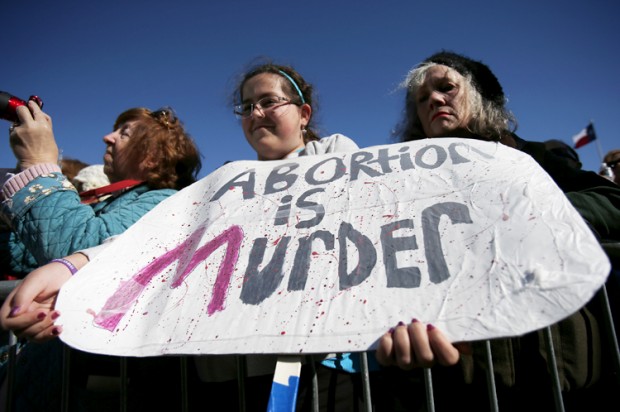The most direct consequence of Thursday’s Supreme Court ruling striking down Massachusetts’ buffer zone law is that the people working and accessing care at abortion clinics will be less safe. Lawmakers in Massachusetts and municipalities across the country with similar measures in place will now have to figure out — once again — how best to ensure that the people who need to enter and exit clinics can continue to do so without being harassed, threatened, harmed or worse by antiabortion protesters. There have been nearly 7,000 incidences of clinic violence since 1977; history teaches us that safety is never a given when walking through those doors.
The second thing that the opinion in McCullen v. Coakley reminds us is how empty — how absolutely devoid of meaning — the notion of “women’s safety” has become in politics. Hardly a week passes without some measure advancing through a state legislature that will have devastating consequences for women’s health, but these bills are nonetheless cloaked in the language of women’s safety. Put those words in front of almost any piece of legislation and it seems like most lawmakers just nod their heads.
Texas comes to mind. We’re one year out from Wendy Davis’ historic filibuster, and the status of access in the state has gone from bad to utterly catastrophic. Nearly half of Texas’ abortion clinics have closed since 2011; it is estimated that come September, there will only be six abortion providers left in the second most populous state in the nation. The Rio Grande Valley has lost its last remaining abortion clinic, and now women in the region must travel 300 miles round trip to access care, including routine services like mammograms, cancer screenings and birth control. A recent study found that 7 percent of women in Texas have attempted to self-induce abortion. The number jumps to 12 percent for women who live along the Mexican border, and it is expected to grow. Women who have the luxury of crossing border checkpoints without fearing deportation or worse have been traveling to flea markets in Mexico to buy drugs from unlicensed and unregulated vendors in order to terminate their pregnancies.
But state Rep. Jodi Laubenberg called the passage of HB 2 a victory for women’s safety. In reflecting on the year that was, she commented, “Authoring and passing House Bill 2 was one of the most rewarding and challenging accomplishments of my legislative service. […] It was worth it. I will continue to fight for both the safety of Texas women and the pre-born.” Her Republican colleagues echoed the sentiment. Republican state Rep. Jane Nelson said, “I am proud to support House Bill 2, which not only protects innocent life but also ensures that abortion facilities are safe for Texas women.” And state Rep. Patricia Harless used the same language to justify her vote. “I proudly voted for House Bill 2 because I believe Texas women deserve more than the bare minimum, lowest level safety standards,” she said.
These talking points have been parroted by lawmakers in Louisiana, Utah, Oklahoma, Arizona, Mississippi, Virginia, North Carolina, South Carolina and virtually everywhere else that laws like these are being enacted. It’s never about abortion. It’s always about safety — women’s safety.
Now the Massachusetts law was also about women’s safety. The kind of safety that 35 feet of distance between yourself and someone willing to spend their Saturdays outside an abortion clinic calling women murderers will provide you. The kind of safety that state lawmakers recognized was urgently needed after an antiabortion activist opened fire on a clinic near Boston and killed two people and injured five others.
The violence isn’t unique to Massachusetts; the threat is national. As Robin Marty wrote this week, if you want to understand why buffer zones matter, spend some time at an abortion clinic without one:
In my time working with abortion providers and abortion rights advocates over the last few years, I’ve seen first hand what is considered “counseling” by abortion opponents at unprotected clinics. In Louisville, Kentucky, one of only two clinics left in the Bluegrass state, I witnessed over 100 abortion opponents lining the sidewalk leading up to the clinic, stopping just at the property line in front of the door, chanting rosaries, calling to patients, preaching sin and eternal damnation through a microphone just a few feet from the waiting room window. I watched a woman shout through the window that the patients inside would die on the exam room table, that they would bleed to death inside, and no one would help them because the money was already paid up front. I saw protesters with bloody, graphic signs swarm patients just trying to get out of the car door and cross the mere 10 feet from curb to clinic property.
That’s what it is like at a clinic with no buffer zone.
And that will be the scene at more clinics in the wake of the Supreme Court’s unanimous finding that while it sees no problem with the buffer zone around its own building, it believes that a 35-foot barrier — the length of a school bus, a walk that will last approximately 7 seconds — is an undue burden on the First Amendment rights of the “peaceful sidewalk counselors” stationed outside. Not being able to follow women to the doors of the clinic apparently limits their ability to “persuade.”
But the burden that removing that buffer will place on women’s safety? Well, what do those words even mean anymore?

